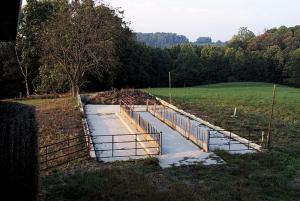2001 - Volume #25, Issue #3, Page #20
[ Sample Stories From This Issue | List of All Stories In This Issue | Print this story
| Read this issue]
He Puts Cattle Feeding Pads Out On Pasture
 |
That was the situation for Ned and Lawrason Sayre, Churchville, Maryland, after they converted to rotational grazing for their 140-cow Angus herd. Daily feeding of bales and constant moving of rings was not a workable long-term solution.
They also have to worry about nutrient management regulations for the Chesapeake Bay area, which meant they needed to address runoff and related water quality issues.
"Our farm is just eight miles from the headwaters of the bay," Ned Sayre says. "We needed to be able to feed efficiently, minimize wasted feed, and manage manure at the same time."
With these goals in mind, the Sayres designed permanent feeding pads out on pasture to give them a place to feed big bales on a solid surface and, at the same time, contain run-off and snow melt that might otherwise carry manure into wetlands and waterways.
The pads consist of a 50-ft. long concrete bunk into which they unroll big bales. On either side of the bunk, there are concrete pads for the cows to stand on while eating. The concrete pads slope toward a 30 by 30-ft. manure storage pit on one end where the Sayres push manure from the pads. The pit is designed with a "picket dam" that releases the manure gradually onto a terrace.
The soil around the feeding pads was graded and covered with landscaping fabric and then paved over with asphalt.
"There's an asphalt plant nearby and we're able to buy used reground material for a reasonable price," Sayre says. "We spread and compact this around the feeding area to help stabilize it and keep cows out of mud.
"The hay bunk area holds 10 or 12 big round bales. That means we don't have to feed every day. We usually scrape the pads once a week or so, and it can be done when we're feeding," Sayre explains. "So in addition to saving feed and managing manure, this system saves us quite a bit of time. Over the course of the feeding season, we figure it saves at least 100 to 125 man hours over feeding bales in rings."
The Sayres have built two pasture feeding pads. They're positioned along fencelines, so cattle from two different pastures can be fed without mingling them or moving cattle from pasture to pasture. They've also constructed hay sheds and calving areas near the feed pads.
While the Sayres have been very pleased with the way the system has worked, they do feel a guttered shed roof over the entire structure would help. By diverting water away from the pit, the terrace could be eliminated and even more feed would be saved in inclement weather.
The Sayres worked with their county Natural Resources Conservation Service office in designing and building the system. The NRCS office has plans and blueprints for construction.
Contact: FARM SHOW Followup, Ned and Lawrason Sayre, 3330 Cool Branch Road, Churchville, Md. 21028 (ph 410 734-7380; E-mail: nedsayre@cs.com) or Harford County NRCS, Suite 103, Forest Hill, Md. 21050 (ph 410 838-6181).

Click here to download page story appeared in.

Click here to read entire issue
To read the rest of this story, download this issue below or click here to register with your account number.




